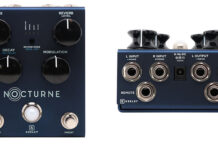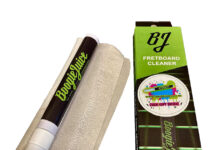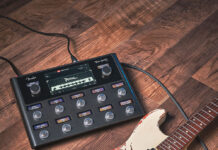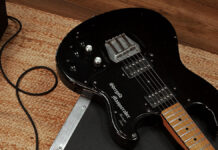George Lynch on Recording KXM's 'Scatterbrain' with dUg Pinnick and Ray Luzier
“With this band, it’s just a big giant happy accident,” George Lynch says. “It feels good. It feels right. And it works.”
The guitarist is discussing KXM, his project with singer-bassist dUg Pinnick (King’s X) and drummer Ray Luzier (Korn), who have just released their sophomore effort, Scatterbrain.
The album is a wild and rollicking ride, from the frenzied, head-snapping intensity of the title track, to the grinding groove of “Breakout” to the dark psychedelia of “Noises in the Sky.” And throughout, Lynch dazzles with the type of six-string pyrotechnics that first established him as a guitar hero with Dokken and that he has continued to espouse with his own Lynch Mob.
After a day in the studio, the guitarist took some time to chat with Guitar World about the making of Scatterbrain, how he approached his guitar parts and KXM’s unique writing and recording process. He also offered some thoughts on his brief reunion with Dokken a few months back, and what the future—if there is one at all—might hold for that version of the band.
How did Scatterbrain come together?
It came together entirely in the studio. The whole concept of KXM is that we create everything on the spot. No preconceived ideas are allowed. Ray [Luzier] is pretty much the songwriting police about that. He can almost sense when you’re bringing in something you sort of already had in your back pocket. He’ll disallow that and he’ll force you to move on by changing it all up. He’ll change the beat on you. [laughs] So our product is improvisation.
How long did it take to put the album together?
Well, Ray lives in Nashville, Doug was in Texas at the time and I’m here in LA. We hadn’t seen each other in quite a while, so we booked a studio in North Hollywood and we just got to work. We spent 12 days on this one, which is two more days than we spent on the last record! That obviously doesn’t include mixing and vocals and all that—after 12 days we didn’t walk out with a finished product. But we did walk out with finished songs.
What do you like about working with Doug and Ray?
Nothing! They’re just bad people. [laughs] You know, it seems like we’re all searching for that perfect gig. Working in any field, you have the problem boss or the person you don’t get along with or the company that isn’t built on the right foundation. There’s always an issue. But with this project it seems like without thinking about it too hard everything just works. And I’m not even going to question why. It’s like, sometimes you build a guitar or you buy a guitar and it’s made of all the wrong stuff, and on paper it shouldn’t sound good or play good. But for some reason it’s the world’s greatest sounding and playing guitar! [laughs]
With this band, I really don’t dissect why it works. I just trust that it works. And for me personally, my biggest obstacle is just getting out of my own way and allowing the chemistry between the three of us to take over. When I go in there I’ll sometimes think too hard about what I’m trying to do. But with this record I consciously tried to flip that switch off. Not that I didn’t want to be thinking—I just didn’t want to force the flow of the ideas. It’s an interesting distinction.
Given the way you guys work, I assume that your leads are for the most part all improvised?
Yeah. What would usually happen was that we’d been hitting it for six or seven hours and the guys would go to take a break. And then it was, “Okay, well, we’ve got the mics on the guitars already, I’ll go into the control room and just go for it.” And then I’d develop ideas while I was in there.
What was your main guitar setup?
I was all over the map. I had an arsenal of guitars in there, for sure. I definitely used my ESP Tele [style guitar] quite a bit. It gets that spank. I love using a Tele in a rock context along with something else. So for tracking, for instance, I’d use the Tele along with a Les Paul. Or alternatively I’d use, like, an ESP Strat-style guitar with, let’s say, my ESP Super V, which is all mahogany, Gibson scale, PAF pickups. It’s that low/mid Les Paul chunk. Combining those two creates sort of a signature kind of sound that fills the whole spectrum, with just two guitars.
There’s a lot of great guitar playing on this record. In particular on the title track. Can you talk about that one?
“Scatterbrain,” it was real interesting because the whole thing was done with a guitar in drop D for the main riff, and then when I went to the verses I switched to an alternate tuning. I had a sort of interesting chord thing that I was playing when we were tracking it all together, but I couldn’t remember the fingering. So when I went in to do overdubs I took another guitar and tuned it to that chord and then played it. It was just some bizarre off-the-top-of-my-head tuning. And I still don’t know what it was. I didn’t write it down. If it ever comes to the point where we take this out live it’ll be very challenging to recreate.
And in the very beginning of the song I use a Whammy pedal. It was just something I was screwing around with. I was doing this octave sweep thing where it was the opposite of what I was doing on the guitar. So it was kind of crossing from low to high. It was an interesting sound so we used it to start the song. So there’s all kinds of different flavors going on on this record. I wanted to make it very interesting for guitar players and guys who appreciate that stuff.
So people might hear something and wonder, “How did he create that sound?” Because I love that about records. My old records, when I was a kid, I’d listen to them and be like, “How did he do that?” “What did he use?” I mean, I could never figure out how Hendrix got the seagull sound on Electric Ladyland. Like, “How the hell…” I thought it was wah wah pedal, or that he was rubbing his pick on the tremolo springs on the back of the body. All these different things.
And then when I was in the studio working on the first KXM record, I had my pedal board in front of my amp, and the amp was turned all the way up and all the effects were on. And the pickups and the speakers did this feedback loop thing and it did that exact sound. I had finally figured it out—45 years later or whatever. [laughs]
That’s why this music is good music. You keep discovering new things in it.
[laughs] Yeah. That was a great day when that happened. I was really jumping around. Nobody gave a shit. Like, “What’s the big deal? So you can make seagull sounds!”
You mentioned earlier that some of the music on Scatterbrain would prove challenging to recreate onstage. Is there a chance you guys will actually go out and do some live shows this time?
That’s the million-dollar question. It’s the number one topic in this band. We had some really great offers after the last record to go out and play some really big shows and we couldn’t do it. And we’re in the same boat now in that we’re all real busy, and Ray especially. There’s no way he can go to Korn and say, “Hey, I need three months off to go tour with KXM.” They’d be like, “What? I don’t think so.” But I love Korn. I think ideally if we could go out with Korn that would be the only way we could do it. But you know, that’s probably not gonna happen.
Recently you also reunited with Dokken for a handful shows, which is something else that a lot of people probably would have thought wasn’t going to happen. How did it go?
I’d say overall it was great. But we just got thrown together after 25 years. I mean, when you do something like that you really want to prep hard for it. But we had a couple rehearsals and then we got thrown out there. So there were some rough spots and I think the stress kind of showed on all of us a little bit. But now that we’ve done it once we’re talking about maybe doing something in 2018. And if that happens I think we’ll be a lot more relaxed and have a little more fun with it.
There’s also a new Dokken CD/DVD package in the works?
Yeah, we’re working on it right now. We wrote a new song that’s going to be on the live CD. A studio track. And that’s finished. And we’re doing one or two semi-acoustic versions of a couple of older Dokken songs. “Will the Sun Rise” is one of them. We finished those as well. They came out great. So yeah, that’ll probably be out near the end of the year, so that’ll be nice.
Source: www.guitarworld.com










